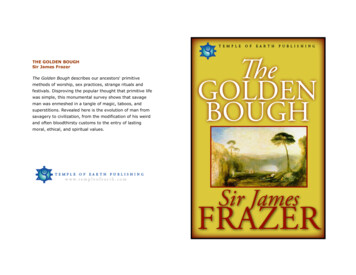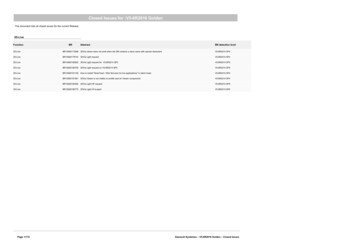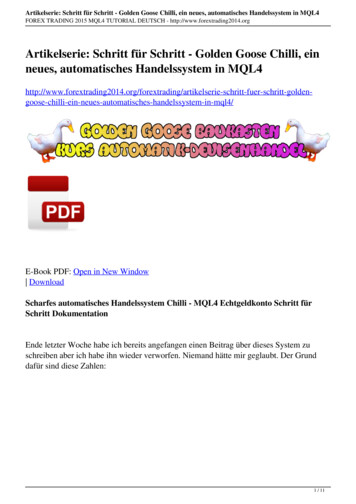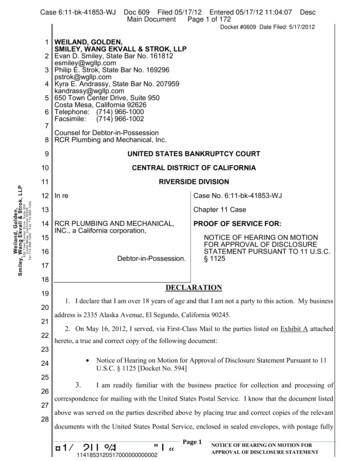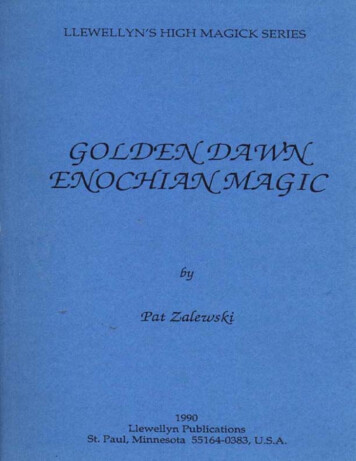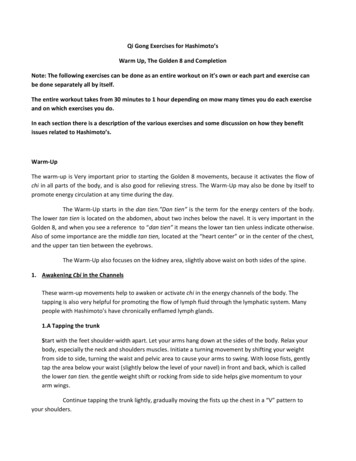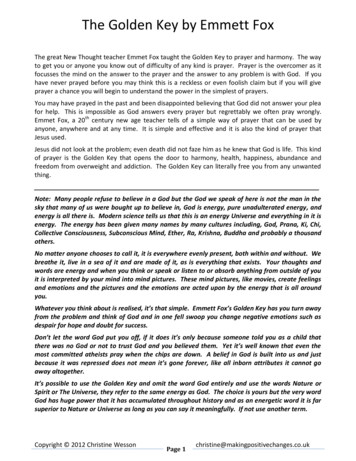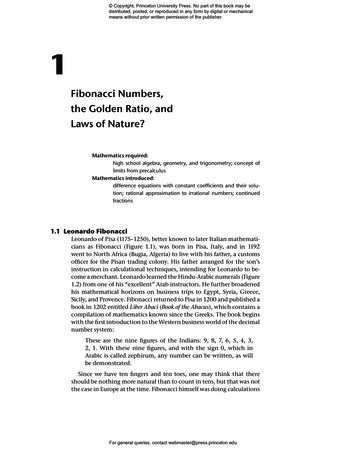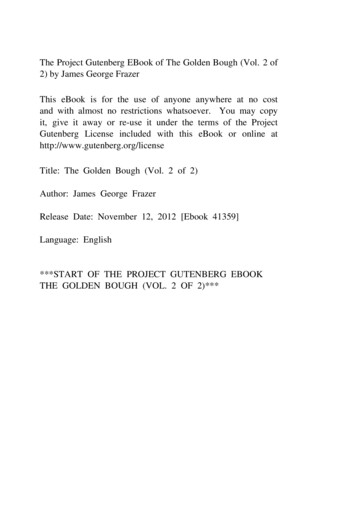
Transcription
The Project Gutenberg EBook of The Golden Bough (Vol. 2 of2) by James George FrazerThis eBook is for the use of anyone anywhere at no costand with almost no restrictions whatsoever. You may copyit, give it away or re-use it under the terms of the ProjectGutenberg License included with this eBook or online athttp://www.gutenberg.org/licenseTitle: The Golden Bough (Vol. 2 of 2)Author: James George FrazerRelease Date: November 12, 2012 [Ebook 41359]Language: English***START OF THE PROJECT GUTENBERG EBOOKTHE GOLDEN BOUGH (VOL. 2 OF 2)***
The Golden BoughA Study in Comparative ReligionByJames George Frazer, M.A.Fellow of Trinity College, CambridgeIn Two Volumes.Vol. II.New York and LondonMacMillan and Co.1894
ContentsChapter III—(continued). . . . . . . . . . .§ 10.—The corn-spirit as an animal. . .§ 11.—Eating the god. . . . . . . . . .§ 12.—Killing the divine animal. . . . .§ 13.—Transference of evil. . . . . . .§ 14.—Expulsion of evils, . . . . . . .§ 15.—Scapegoats. . . . . . . . . . . .§ 16.—Killing the god in Mexico. . . .Chapter IV—The Golden Bough. . . . . . .§ 1.—Between heaven and earth. . . . .§ 2.—Balder. . . . . . . . . . . . . . .§ 3.—The external soul in folk-tales. . .§ 4.—The external soul in folk-custom.§ 5.—Conclusion. . . . . . . . . . . . .Note. Offerings of first-fruits. . . . . . . . .Index. . . . . . . . . . . . . . . . . . . . .Footnotes . . . . . . . . . . . . . . . . . .226181134142165197202202220268295323335349443
[Transcriber's Note: The above cover image was produced bythe submitter at Distributed Proofreaders, and is being placedinto the public domain.][001]
Chapter III—(continued).§ 10.—The corn-spirit as an animal.[002]In some of the examples cited above to establish the meaningof the term “neck” as applied to the last sheaf, the corn-spiritappears in animal form as a gander, a goat, a hare, a cat, and afox. This introduces us to a new aspect of the corn-spirit, whichwe must now examine. By doing so we shall not only have freshexamples of killing the god, but may hope also to clear up somepoints which remain obscure in the myths and worship of Attis,Adonis, Osiris, Dionysus, Demeter, and Virbius.Amongst the many animals whose forms the corn-spirit issupposed to take are the wolf, dog, hare, cock, goose, cat, goat,cow (ox, bull), pig, and horse. In one or other of these forms thecorn-spirit is believed to be present in the corn, and to be caughtor killed in the last sheaf. As the corn is being cut the animalflees before the reapers, and if a reaper is taken ill on the field, heis supposed to have stumbled unwittingly on the corn-spirit, whohas thus punished the profane intruder. It is said “The Rye-wolfhas got hold of him,” “the Harvest-goat has given him a push.”The person who cuts the last corn or binds the last sheaf gets thename of the animal, as the Rye-wolf, the Rye-sow, the Oats-goat,etc., and retains the name sometimes for a year. Also the animalis frequently represented by a puppet made out of the last sheafor of wood, flowers, etc., which is carried home amid rejoicingson the last harvest waggon. Even where the last sheaf is not made
§ 10.—The corn-spirit as an animal.3up in animal shape, it is often called the Rye-wolf, the Hare,Goat, and so on. Generally each kind of crop is supposed to haveits special animal, which is caught in the last sheaf, and calledthe Rye-wolf, the Barley-wolf, the Oats-wolf, the Pea-wolf, orthe Potato-wolf, according to the crop; but sometimes the figureof the animal is only made up once for all at getting in the lastcrop of the whole harvest. Sometimes the animal is believed tobe killed by the last stroke of the sickle or scythe. But oftener it isthought to live so long as there is corn still unthreshed, and to becaught in the last sheaf threshed. Hence the man who gives thelast stroke with the flail is told that he has got the Corn-sow, theThreshing-dog, etc. When the threshing is finished, a puppet ismade in the form of the animal, and this is carried by the thresherof the last sheaf to a neighbouring farm, where the threshing isstill going on. This again shows that the corn-spirit is believedto live wherever the corn is still being threshed. Sometimes thethresher of the last sheaf himself represents the animal; and if thepeople of the next farm, who are still threshing, catch him, theytreat him like the animal he represents, by shutting him up in thepig-sty, calling him with the cries commonly addressed to pigs,and so forth.1These general statements will now be illustrated by examples.We begin with the corn-spirit conceived as a wolf or a dog.This conception is common in France, Germany, and Slavoniccountries. Thus, when the wind sets the corn in wave-like motion,the peasants often say, “The Wolf is going over, or through, thecorn,” “the Rye-wolf is rushing over the field,” “the Wolf is inthe corn,” “the mad Dog is in the corn,” “the big Dog is there.”2When children wish to go into the corn-fields to pluck ears orgather the blue corn-flowers, they are warned not to do so, for1W. Mannhardt, Die Korndämonen, pp. 1-6.W. Mannhardt, Roggenwolf und Roggenhund (Danzig, 1865), p. 5; id.,Antike Wald-und Feldkulte, p. 318 sq.; id., Mythol. Forsch. p. 103; Witzschel,Sagen, Sitten und Gebräuche aus Thüringen, p. 213.2[003]
4The Golden Bough (Vol. 2 of 2)“the big Dog sits in the corn,” or “the Wolf sits in the corn,and will tear you in pieces,” “the Wolf will eat you.” The wolfagainst whom the children are warned is not a common wolf,for he is often spoken of as the Corn-wolf, Rye-wolf, etc.; thusthey say, “The Rye-wolf will come and eat you up, children,”“the Rye-wolf will carry you off,” and so forth.3 Still he has allthe outward appearance of a wolf. For in the neighbourhood ofFeilenhof (East Prussia), when a wolf was seen running througha field, the peasants used to watch whether he carried his tailin the air or dragged it on the ground. If he dragged it on theground, they went after him, and thanked him for bringing thema blessing, and even set tit-bits before him. But if he carried histail high, they cursed him and tried to kill him. Here the wolf isthe corn-spirit, whose fertilising power is in his tail.4[004]Both dog and wolf appear as embodiments of the corn-spirit inharvest-customs. Thus in some parts of Silesia the person whobinds the last sheaf is called the Wheat-dog or the Peas-pug.5But it is in the harvest-customs of the north-east of France thatthe idea of the Corn-dog comes out most clearly. Thus whena harvester, through sickness, weariness, or laziness, cannot orwill not keep up with the reaper in front of him, they say, “TheWhite Dog passed near him,” “he has the White Bitch,” or “theWhite Bitch has bitten him.”6 In the Vosges the Harvest-May iscalled the “Dog of the harvest.”7 About Lons-le-Saulnier, in theJura, the last sheaf is called the Bitch. In the neighbourhood ofVerdun the regular expression for finishing the reaping is, “Theyare going to kill the Dog;” and at Épinal they say, according tothe crop, “We will kill the Wheat-dog, or the Rye-dog, or the34567W. Mannhardt, Roggenwolf u. Roggenhund, p. 7 sqq.; id., A. W. F. p. 319.W. Mannhardt, Roggenwolf, etc. p. 10.W. Mannhardt, M. F. p. 104.Ib.Ib. p. 104 sq. On the Harvest-May, see above, vol. i. p. 68.
§ 10.—The corn-spirit as an animal.5Potato-dog.”8 In Lorraine it is said of the man who cuts the lastcorn, “He is killing the Dog of the harvest.”9 At Dux, in theTyrol, the man who gives the last stroke at threshing is said to“strike down the Dog;”10 and at Ahnebergen, near Stade, he iscalled, according to the crop, Corn-pug, Rye-pug, Wheat-pug.11So with the wolf. In Germany it is said that “The Wolf sitsin the last sheaf.”12 In some places they call out to the reaper,“Beware of the Wolf;” or they say, “He is chasing the Wolfout of the corn.”13 The last bunch of standing corn is calledthe Wolf, and the man who cuts it “has the Wolf.” The lastsheaf is also called the Wolf; and of the woman who binds itthey say, “The Wolf is biting her,” “she has the Wolf,” “shemust fetch the Wolf” (out of the corn).14 Moreover, she isherself called Wolf and has to bear the name for a whole year;sometimes, according to the crop, she is called the Rye-wolf orthe Potato-wolf.15 In the island of Rügen they call out to thewoman who binds the last sheaf, “You're Wolf;” and when shecomes home she bites the lady of the house and the stewardess,for which she receives a large piece of meat. The same womanmay be Rye-wolf, Wheat-wolf, and Oats-wolf, if she happensto bind the last sheaf of rye, wheat, and oats.16 At Buir, in thedistrict of Cologne, it was formerly the custom to give to the lastsheaf the shape of a wolf. It was kept in the barn till all the cornwas threshed. Then it was brought to the farmer, and he had tosprinkle it with beer or brandy.17 In many places the sheaf called891011121314151617Ib. p. 105.Ib. p. 30.Ib. pp. 30, 105.Ib. p. 105 sq.A. W. F. p. 320; Roggenwolf, p. 24.Roggenwolf, p. 24.Roggenwolf, p. 24.Ib. p. 25.Ib. p. 28; A. W. F. p. 320.Roggenwolf, p. 25.[005]
6[006]The Golden Bough (Vol. 2 of 2)the Wolf is made up in human form and dressed in clothes. Thisindicates a confusion between the conceptions of the corn-spiritas theriomorphic (in animal form) and as anthropomorphic (inhuman form).18 Generally the Wolf is brought home on the lastwaggon, with joyful cries.19Again, the Wolf is supposed to hide himself amongst the cutcorn in the granary, until he is driven out of the last bundle by thestrokes of the flail. Hence at Wanzleben, near Magdeburg, afterthe threshing the peasants go in procession, leading by a chaina man, who is enveloped in the threshed out straw and is calledthe Wolf.20 He represents the corn-spirit who has been caughtescaping from the threshed corn. In Trier it is believed that theCorn-wolf is killed at threshing. The men thresh the last sheaftill it is reduced to chopped straw. In this way they think that theCorn-wolf who was lurking in the last sheaf, has been certainlykilled.21In France also the Corn-wolf appears at harvest. Thus theycall out to the reaper of the last corn, “You will catch the Wolf.”Near Chambéry they form a ring round the last standing corn,and cry, “The Wolf is in there.” In Finisterre, when the reapingdraws near an end, the harvesters cry, “There is the Wolf; wewill catch him.” Each takes a swath to reap, and he who finishesfirst calls out, “I've caught the Wolf.”22 In Guyenne, when thelast corn has been reaped, they lead a wether all round the field.It is called “the Wolf of the field.” Its horns are decked witha wreath of flowers and corn-ears, and its neck and body arealso encircled with garlands and ribbons. All the reapers march,singing, behind it. Then it is killed on the field. In this part ofFrance the last sheaf is called the coujoulage, which, in the patois,1819202122Ib. p. 26.Ib. p. 26; A. W. F. p. 320.A. W. F. p. 321.A. W. F. p. 321 sq.A. W. F. p. 320.
§ 10.—The corn-spirit as an animal.7means a wether. Hence the killing of the wether represents thedeath of the corn-spirit, considered as present in the last sheaf;but two different conceptions of the corn-spirit—as a wolf andas a wether—are mixed up together.23Sometimes it appears to be thought that the Wolf, caught in thelast corn, lives during the winter in the farmhouse, ready to renewhis activity as corn-spirit in the spring. Hence at midwinter, whenthe lengthening days begin to herald the approach of spring, theWolf makes his appearance once more. In Poland a man, witha wolf's skin thrown over his head, is led about at Christmas;or a stuffed wolf is carried about by persons who collectmoney.24 There are facts which point to an old custom of leadingabout a man enveloped in leaves and called the Wolf, while hisconductors collected money.25Another form which the corn-spirit often assumes is that ofa cock. In Austria children are warned against straying in thecorn-fields, because the Corn-cock sits there, and will peck theireyes out.26 In North Germany they say that “the Cock sitsin the last sheaf;” and at cutting the last corn the reapers cry,“Now we will chase out the Cock.” When it is cut they say,“We have caught the Cock.” Then a cock is made of flowers,fastened on a pole, and carried home by the reapers, singing asthey go.27 At Braller, in Transylvania, when the reapers cometo the last patch of corn, they cry, “Here we shall catch theCock.”28 At Fürstenwalde, when the last sheaf is about to bebound, the master lets loose a cock, which he has brought in a23A. W. F. p. 320 sq.A. W. F. p. 322.25Ib. p. 323.26Die Korndämonen, p. 13.27Ib.; Schmitz, Sitten und Sagen des Eifler Volkes, i. p. 95; Kuhn, WestfälischeSagen, Märchen und Gebräuche, ii. p. 181; Kuhn und Schwartz, NorddeutscheSagen, Märchen und Gebräuche, p. 398.28G. A. Heinrich, Agrarische Sitten und Gebräuche unter den SachsenSiebenbürgens, p. 21.24[007]
8[008]The Golden Bough (Vol. 2 of 2)basket, and lets it run over the field. All the harvesters chaseit till they catch it. Elsewhere the harvesters all try to seize thelast corn cut; he who succeeds in grasping it must crow, andis called Cock.29 The last sheaf is called Cock, Cock-sheaf,Harvest-cock, Harvest-hen, Autumn-hen. A distinction is madebetween a Wheat-cock, Bean-cock, etc., according to the crop.30At Wünschensuhl, in Thüringen, the last sheaf is made into theshape of a cock, and called Harvest-cock.31 A figure of a cock,made of wood, pasteboard, or ears of corn, is borne in frontof the harvest-waggon, especially in Westphalia, where the cockcarries in his beak fruits of the earth of all kinds. Sometimes theimage of the cock is fastened to the top of a May-tree on the lastharvest-waggon. Elsewhere a live cock, or a figure of one, isattached to a harvest-crown and carried on a pole. In Galicia andelsewhere this live cock is fastened to the garland of corn-earsor flowers, which the leader of the women-reapers carries onher head as she marches in front of the harvest procession.32 InSilesia a live cock is presented to the master on a plate. Theharvest supper is called Harvest-cock, Stubble-cock, etc., anda chief dish at it, at least in some places, is a cock.33 If awaggoner upsets a harvest-waggon, it is said that “he has spiltthe Harvest-cock,” and he loses the cock—that is, the harvestsupper.34 The harvest-waggon, with the figure of the cock on it,29Die Korndämonen, p. 13. Cp. Kuhn and Schwartz, l.c.Die Korndämonen, p. 13.31Witzschel, Sagen, Sitten und Gebräuche aus Thüringen, p. 220.32Die Korndämonen, p. 13 sq.; Kuhn, Westfälische Sagen, Märchen undGebräuche, ii. p. 180 sq.; Pfannenschmid, Germanische Erntefeste, p. 110.33Die Korndämonen, p. 14; Pfannenschmid, op. cit. pp. 111, 419 sq.34Die Korndämonen, p. 15. So in Shropshire, where the corn-spirit isconceived in the form of a gander (see above, vol. i. p. 407), the expression foroverthrowing a load at harvest is “to lose the goose,” and the penalty used tobe the loss of the goose at the harvest supper (Burne and Jackson, ShropshireFolk-lore, p. 375); and in some parts of England the harvest supper was calledthe Harvest Gosling, or the Inning Goose (Brand, Popular Antiquities, ii. 23,26, Bohn's ed.)30
§ 10.—The corn-spirit as an animal.9is driven round the farmhouse before it is taken to the barn. Thenthe cock is nailed over, or at the side of the house door, or onthe gable, and remains there till next harvest.35 In East Frieslandthe person who gives the last stroke at threshing is called theClucking-hen, and grain is strewed before him as if he were ahen.36Again, the corn-spirit is killed in the form of a cock. In parts ofGermany, Hungary, Poland, and Picardy, the reapers place a livecock in the corn which is to be cut last, and chase it over the field,or bury it up to the neck in the ground; afterwards they strike offits head with a sickle or scythe.37 In many parts of Westphalia,when the harvesters bring the wooden cock to the farmer, hegives them a live cock, which they kill with whips or sticks, orbehead with an old sword, or throw it into the barn to the girls,or give it to the mistress to cook. If the Harvest-cock has notbeen spilt—that is, if no waggon has been upset—the harvestershave the right of killing the farmyard cock by throwing stones atit or beheading it. Where this custom has fallen into disuse, itis still common for the farmer's wife to make cockie-leekie forthe harvesters, and to show them the head of the cock which hasbeen killed for the soup.38 In the neighbourhood of Klausenburg,Transylvania, a cock is buried on the harvest-field in the earth, sothat only its head appears. A young man then takes a scythe andcuts off the cock's head at a single stroke. If he fails to do this, heis called the Red Cock for a whole year, and people fear that nextyear's crop will be bad.39 In the neighbourhood of Udvarhely,Transylvania, a live cock is bound up in the last sheaf and killedwith a spit. It is then skinned. The flesh is thrown away, but theskin and feathers are kept till next year; and in spring the grain3536373839Die Korndämonen, p. 14.Ib. p. 15.M. F. p. 30.Die Korndämonen, p. 15.Ib. p. 15 sq.[009]
10[010]The Golden Bough (Vol. 2 of 2)from the last sheaf is mixed with the feathers of the cock andscattered on the field which is to be tilled.40 Nothing could setin a clearer light the identification of the cock with the spirit ofthe corn. By being tied up in the last sheaf and killed, the cock isidentified with the corn, and its death with the cutting of the corn.By keeping its feathers till spring, then mixing them with theseed-corn taken from the very sheaf in which the bird had beenbound, and scattering the feathers together with the seed over thefield, the identity of the bird with the corn is again emphasised,and its quickening and fertilising power, as the corn-spirit, isintimated in the plainest manner. Thus the corn-spirit, in theform of a cock, is killed at harvest, but rises to fresh life andactivity in spring. Again, the equivalence of the cock to the cornis expressed, hardly less plainly, in the custom of burying thebird in the ground, and cutting off its head (like the ears of corn)with the scythe.Another common embodiment of the corn-spirit is the hare.41In some parts of Ayrshire the cutting of the last corn is called“cutting the Hare;”42 and in Germany a name for the last sheafis the Hare.43 In East Prussia they say that the Hare sits in thelast patch of standing corn, and must be chased out by the lastreaper. The reapers hurry with their work, each being anxiousnot to have “to chase out the Hare;” for the man who does so,that is, who cuts the last corn, is much laughed at.44 At Birk inTransylvania, when the reapers come to the last patch, they cryout, “We have the Hare.”45 At Aurich, as we have seen,46 anexpression for cutting the last corn is “to cut off the Hare's tail.”40Ib. p. 15; M. F. p. 30.Die Korndämonen, p. 1.42Folk-lore Journal, vii. 47.43Die Korndämonen, p. 3.44Lemke, Volksthümliches in Ostpreussen, i. 24.45G. A. Heinrich, Agrarische Sitten und Gebräuche unter den SachsenSiebenbürgens, p. 21.46Above, vol. i. p. 408.41
§ 10.—The corn-spirit as an animal.11“He is killing the Hare” is commonly said of the man who cutsthe last corn in Germany, Sweden, Holland, France, and Italy.47In Norway the man who is thus said to “kill the Hare” must give“hare's blood,” in the form of brandy, to his fellows to drink.48Again, the corn-spirit sometimes takes the form of a cat.49Near Kiel children are warned not to go into the corn-fieldsbecause “the Cat sits there.” In the Eisenach Oberland they aretold “the Corn-cat will come and fetch you,” “the Corn-cat goesin the corn.” In some parts of Silesia at mowing the last corn theysay, “the Cat is caught;” and at threshing, the man who givesthe last stroke is called the Cat. In the neighbourhood of Lyonsthe last sheaf and the harvest supper are both called the Cat.About Vesoul when they cut the last corn they say, “We havethe Cat by the tail.” At Briançon, in Dauphiné, at the beginningof reaping, a cat is decked out with ribbons, flowers, and earsof corn. It is called the Cat of the ball-skin (le chat de peau deballe). If a reaper is wounded at his work, they make the cat lickthe wound. At the close of the reaping the cat is again deckedout with ribbons and ears of corn; then there is dancing andmerriment. When the dance is over, the cat is solemnly strippedof its ornaments by the girls. At Grüneberg in Silesia the reaperwho cuts the last corn is called the Tom-cat. He is enveloped inrye-stalks and green withes, and is furnished with a long plaitedtail. Sometimes as a companion he has a man similarly dressed,who is called the (female) Cat. Their duty is to run after peoplewhom they see and beat them with a long stick. Near Amiens theexpression for finishing the harvest is, “They are going to kill theCat;” and when the last corn is cut a cat is killed in the farmyard.At threshing, in some parts of France, a live cat is placed underthe last bundle of corn to be threshed, and is struck dead with theflails. Then on Sunday it is roasted and eaten as a holiday dish.474849M. F. p. 29.M. F. p. 29 sq.; Die Korndämonen, p. 5.A. W. F. pp. 172-174; M. F. p. 30.[011][012]
12[013]The Golden Bough (Vol. 2 of 2)Further, the corn-spirit often appears in the form of a goat. Inthe province of Prussia, when the corn bends before the wind,they say, “The Goats are chasing each other,” “the wind is drivingthe Goats through the corn,” “the Goats are browsing there,” andthey expect a very good harvest. Again they say, “the Oatsgoat is sitting in the oats-field,” “the Corn-goat is sitting in therye-field.”50 Children are warned not to go into the corn-fieldsto pluck the blue cornflowers, or amongst the beans to pluckpods, because the Rye-goat, the Corn-goat, the Oats-goat, or theBean-goat is sitting or lying there, and will carry them awayor kill them.51 When a harvester is taken sick or lags behindhis fellows at their work, they call out, “The Harvest-goat haspushed him,” “he has been pushed by the Corn-goat.”52 In theneighbourhood of Braunsberg (East Prussia) at binding the oatsevery harvester makes haste “lest the Corn-goat push him.” AtOefoten in Norway each harvester has his allotted patch to reap.When a harvester in the middle has not finished reaping his pieceafter his neighbours have finished theirs, they say of him, “Heremains on the island.” And if the laggard is a man, they imitatethe cry with which they call a he-goat; if a woman, the cry withwhich they call a she-goat.53 Near Straubing in Lower Bavaria,it is said of the man who cuts the last corn that “he has theCorn-goat or the Wheat-goat, or the Oats-goat,” according to thecrop. Moreover, two horns are set up on the last heap of corn,and it is called “the horned Goat.” At Kreutzburg, East Prussia,they call out to the woman who is binding the last sheaf, “TheGoat is sitting in the sheaf.”54 At Gablingen in Swabia, when thelast field of oats upon a farm is being reaped, the reapers carvea goat out of wood. Ears of oats are inserted in its nostrils and5051525354W. Mannhardt, A. W. F. p. 155 sq.Ib. p. 157 sq.Ib. p. 159.Ib. p. 161 sq.W. Mannhardt, A. W. F. p. 162.
§ 10.—The corn-spirit as an animal.13mouth, and it is adorned with garlands of flowers. It is set uponthe field and called the Oats-goat. When the reaping approachesan end, each reaper hastens to finish his piece first; he who is thelast to finish gets the Oats-goat.55 Again, the last sheaf is itselfcalled the Goat. Thus, in the valley of the Wiesent, Bavaria, thelast sheaf bound on the field is called the Goat, and they havea proverb, “The field must bear a goat.”56 At Spachbrücken inHesse, the last handful of corn which is cut is called the Goat,and the man who cuts it is much ridiculed.57 Sometimes the lastsheaf is made up in the form of a goat,58 and they say, “TheGoat is sitting in it.” Again, the person who cuts or binds thelast sheaf is called the Goat. Thus, in parts of Mecklenburg theycall out to the woman who binds the last sheaf, “You are theHarvest-goat.” In the neighbourhood of Uelzen in Hanover, theharvest festival begins with “the bringing of the Harvest-goat;”that is, the woman who bound the last sheaf is wrapt in straw,crowned with a harvest-wreath, and brought in a wheelbarrowto the village, where a round dance takes place. About Lüneburg,also, the woman who binds the last corn is decked with a crownof corn-ears and is called the Corn-goat.59 In the Canton St.Gall, Switzerland, the person who cuts the last handful of cornon the field, or drives the last harvest-waggon to the barn, iscalled the Corn-goat or the Rye-goat, or simply the Goat.60 Inthe Canton Thurgau he is called Corn-goat; like a goat he has abell hung round his neck, is led in triumph, and drenched withliquor. In parts of Styria, also, the man who cuts the last cornis called Corn-goat, Oats-goat, etc. As a rule, the man who thusgets the name of Corn-goat has to bear it a whole year till the55Panzer, Beitrag zur deutschen Mythologie, ii. p. 232 sq. No. 426; A. W. F.p. 162.56Panzer, op. cit. ii. p. 228 sq. No. 422; A. W. F. p. 163.57A. W. F. p. 163.58Ib. p. 164.59A. W. F. p. 164.60Ib. p. 164 sq.[014]
14[015]The Golden Bough (Vol. 2 of 2)next harvest.61According to one view, the corn-spirit, who has been caughtin the form of a goat or otherwise, lives in the farmhouse orbarn over winter. Thus, each farm has its own embodiment ofthe corn-spirit. But, according to another view, the corn-spirit isthe genius or deity, not of the corn of one farm only, but of allthe corn. Hence when the corn on one farm is all cut, he fleesto another where there is still corn left standing. This idea isbrought out in a harvest-custom which was formerly observed inSkye. The farmer who first finished reaping sent a man or womanwith a sheaf to a neighbouring farmer who had not finished; thelatter in his turn, when he had finished, sent on the sheaf to hisneighbour who was still reaping; and so the sheaf made the roundof the farms till all the corn was cut. The sheaf was called thegoabbir bhacagh, that is, the Cripple Goat.62 The corn-spirit wasprobably thus represented as lame because he had been crippledby the cutting of the corn. We have seen that sometimes the oldwoman who brings home the last sheaf must limp on one foot.63In the Böhmer Wald mountains, between Bohemia and Bavaria,when two peasants are driving home their corn together, theyrace against each other to see who shall get home first. Thevillage boys mark the loser in the race, and at night they comeand erect on the roof of his house the Oats-goat, which is acolossal figure of a goat made of straw.64But sometimes the corn-spirit, in the form of a goat, is believedto be slain on the harvest-field by the sickle or scythe. Thus,in the neighbourhood of Bernkastel, on the Moselle, the reapersdetermine by lot the order in which they shall follow each other.The first is called the fore-reaper, the last the tail-bearer. If areaper overtakes the man in front he reaps past him, bending61626364Ib. p. 165.Brand, Popular Antiquities, ii. 24, Bohn's ed.; A. W. F. p. 165.Above, vol. i. p. 380.A. W. F. p. 165.
§ 10.—The corn-spirit as an animal.15round so as to leave the slower reaper in a patch by himself. Thispatch is called the Goat; and the man for whom “the Goat is cut”in this way, is laughed and jeered at by his fellows for the restof the day. When the tail-bearer cuts the last ears of corn, it issaid “He is cutting the Goat's neck off.”65 In the neighbourhoodof Grenoble, before the end of the reaping, a live goat is adornedwith flowers and ribbons and allowed to run about the field. Thereapers chase it and try to catch it. When it is caught, the farmer'swife holds it fast while the farmer cuts off its head. The goat'sflesh serves to furnish the harvest supper. A piece of the flesh ispickled and kept till the next harvest, when another goat is killed.Then all the harvesters eat of the flesh. On the same day the skinof the goat is made into a cloak, which the farmer, who workswith his men, must always wear at harvest-time if rain or badweather sets in. But if a reaper gets pains in his back, the farmergives him the goat-skin to wear.66 The reason for this seems tobe that the pains in the back, being inflicted by the corn-spirit,can also be healed by it. Similarly we saw that elsewhere, whena reaper is wounded at reaping, a cat, as the representative of thecorn-spirit, is made to lick the wound.67 Esthonian reapers in theisland of Mon think that the man who cuts the first ears of cornat harvest will get pains in his back,68 —probably because thecorn-spirit is believed to resent especially the first wound; and, inorder to escape pains in the back, Saxon reapers in Transylvaniagird their loins with the first handful of ears which they cut.69Here, again, the corn-spirit is applied to for healing or protection,but in his original vegetable form, not in the form of a goat or acat.65A. W. F. p. 166; M. F. p. 185.A. W. F. p. 166.67Above, p. 11.68Holzmayer, Osiliana, p. 107.69G. A. Heinrich, Agrarische Sitten u.Siebenbürgens, p. 19. Cp. B. K. p. 482 sqq.66Gebräuche unter den Sachsen[016]
16[017]The Golden Bough (Vol. 2 of 2)Further, the corn-spirit under the form of a goat is sometimesconceived as lurking among the cut corn in the barn, till heis driven from it by the threshing-flail. For example, in theneighbourhood of Marktl in Upper Bavaria the sheaves are calledStraw-goats or simply Goats. They are laid in a great heap on theopen field and threshed by two rows of men standing oppositeeach other, who, as they ply their flails, sing a song in whichthey say that they see the Straw-goat amongst the corn-stalks.The last Goat, that is, the last sheaf,
Nov 12, 2012 · The Project Gutenberg EBook of The Golden Bough (Vol. 2 of 2) by James George Frazer . catch him, they treat him like the animal he represents, by shutting him up in the pig-sty, calling him with the cries commonly addressed to pigs, . will not keep up with th
